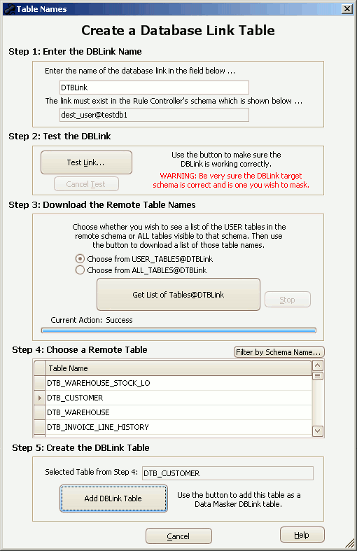The New Create Database Link Table Form
Published 26 March 2018
The Create Database Link Table Form
In some circumstances (particularly Table-To-Table Synchronization) it is necessary to operate on a table in a different schema. If the schema containing the table is not in the same database, then the remote table must be accessed via a database link. The Create Database Link Table form enables the configuration of a remote table, accessed via a database link, into the masking set. Once added, the various masking rules can transparently use the database link table as the target of masking operations.
The Create Database Link Table form is launched from the Create/Edit Rule Controller form. The process of creating a database link table requires knowledge of the name of the database link, the download of the table names from the remote schema via the link, the selection of a target table and the download of that tables DDL structure.
Since so much information is required in order to create a database link table, the form has been designed in a series of steps designed to lead you through the process.
Step 1
Enter the name of the database link into the Database Link Name field. This database link must exist in the schema to which the Rule Controller connects.
Important Note: It is important to be sure that you know exactly which schema the specified link connects to. This includes checking the accuracy of the TNSNames entry. If you do not get this right you could be performing masking operations on a completely different schema and database.
Step 2
Test the database link by clicking on the Test Link button. If the database link does not function correctly, then this issue must be resolved before the remainder of the database link table creation steps can be performed.
Step 3
Fetch the names of the tables from the remote schema by pressing on the Get List of Tables@DBLink button. The remote schema is the schema to which the database link connects and by default the USER_TABLES view in that schema is queried for the table names. If you wish to operate on tables which are in the same database as the remote schema but in a different schema you can check the Choose from ALL_TABLES option. Note that in order for the other schemas tables to be visible in the ALL_TABLES view, the remote schema must have the appropriate permissions on them.
Step 4
On completion of Step 3, the list of table names will be presented as a list in Step 4. If the ALL_TABLES option was enabled, the schema name for each table will also be presented. Choose a table from the list by clicking on it with the mouse. This is the table which will be created as a database link table. Also note the table names visible on the display can be filtered by schema name using the Filter by Schema Name button.
Step 5
The table name selected in Step 4 will appear in the Selected Table field in Step 5. Press the Add DBLink Table button to create a database link table in the masking set. The act of adding the table to the set will also cause the tables column structure to be downloaded from the remote database.
Once created, the database link table will be visible in the Tables in Set tab. Database link tables are readily identifiable by the @DBLink text appended to the table name. For example, a table named SUPPLIER in the remote PURCHASING schema accessed via the PURCHLINK database link would appear in the table name list as SUPPLIER@PURCHLINK. If the database link table was created using the ALL_TABLES option and was in a different schema than the remote PURCHASING schema the table name will also have the remote schema name prepended to the table name. For example HR.SUPPLIER@PURCHLINK
The various masking rules will automatically detect the fact that the table is remotely accessed via a database link and optimize their masking algorythms and code. The use of a database link table in a masking rule is, for the most part, the same as using any other table. However, it is not possible to use DBLink Tables with Shuffle or Table-Internal Synch. rules. All other masking rule types support the use of DBLink Tables.





